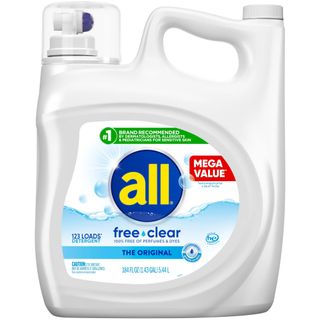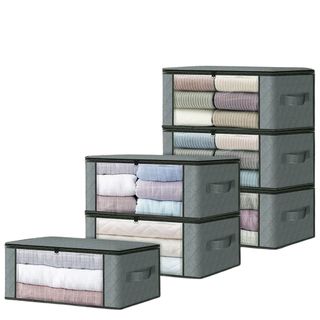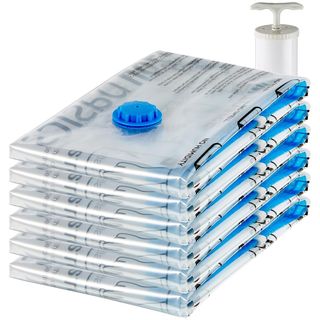How to store a comforter or duvet properly over the warmer months – pros say 'breathable is the buzzword'
Clean, air out, fold and roll your way to a fresh and fluffy duvet


If you've been overheating at night, learning how to store a comforter or duvet that's better suited for winter weather and switching to a lighter spring alternative will be a game-changer.
This way, you can store your winter bedding without it being in the way all summer and keep it smelling fresh and feeling fluffy, ready for the next cozy season.
Taking the time and steps to do so correctly is one of the things people who store bed linen properly always do, so here, professional organizers share their step-by-step tips to keep your cozy comforter in tip-top condition when storing.
How to store a comforter or duvet over summer months
Step 1: Start with cleaning

Taking the time to wash your duvet or comforter before storing it will help prevent any musty odors.
First things first, before storing your winter comforter, it's crucial to wash your comforter.
Di Ter Avest, professional organizer and founder of Diisorganized, advises, 'Before storing, always wash your duvet according to the laundry symbols on the care label. Most duvets can go in a large-capacity washing machine on a gentle cycle with mild detergent,' such as the Tide Free & Gentle Laundry Detergent Liquid available at Walmart.
'If it’s too big, you can take it to a laundromat or dry cleaner.' This is usually recommended when washing a down comforter, too, particularly if you're worried about damage, as Ben Soreff, professional organizer at House to Home Organizing, warns that extra care must be taken in this circumstance.
'This is an important step to eliminate any leftover sweat, dust, or oils that can cause musty smells and attract pests over time,' adds Di.
All prices were correct at the time of publication.

This hypoallergenic laundry detergent is free of any perfumes and dyes, and is tough on stains yet gentle on skin.
Step 2: Air it out

Airing out your bedding before storage will help to prevent musty odors and mildew.
Then, to dry your comforter or duvet, if possible, harness the benefits of air-drying laundry and let it dry completely – either outside on a sunny day, or in a well-ventilated space.
If this isn't possible, you can use a dryer on a low heat, says Ben, but even if you do so, it's best to air out bedding outdoors afterward. This will help prevent any trapped moisture which may lead to mold, mildew, or weird musty smells when you come to unpack it come winter.
'Finally, give it a good shake,' adds Ben. 'Removing the cover is recommended for storage breathability.'

A wet duvet or comforter can be very heavy, so it's important to use a clothesline or drying rack that's up to the job. This retractable one is easy to set up and install and holds up to 40 lbs.
Step 3: Fold it properly

Fold or roll your comforter or duvet, depending on the type.
Then, following the same technique as when folding blankets, fold your comforter or duvet neatly for storage.
'Lay it flat and smooth out any wrinkles,' says Di. 'Fold it in thirds lengthwise, then fold it again into a compact square or roll it up.' If you're unsure which to go for, Ben recommends that a down duvet should be rolled while non-natural fibers are fine to fold.
'Folding or rolling the duvet properly will help prevent deep creases and keep the filling from clumping.'
Step 4: Store in a cool, dry place

Always store your bedding away from sunlight and moisture.
Finally, your fresh and folded winter comforter is ready for storage. Opting for a cool, dry place is best.
'Wherever you store your duvet, make sure it's not in direct sunlight or a damp area, like a basement,' advises Di. 'Sunlight can fade fabric, and moisture can lead to mold or mildew.'
Now, choosing the best storage to store your comforter will depend on your space and lifestyle.
'Some people are fine storing a duvet loose in a linen closet as long as it is cool and free from moisture,' says Ben. 'However, if the duvet is expensive, a specific duvet storage bag works best. Try and avoid using plastic, since our goal is always for the duvet to breathe. You can use an acid-free box if you have the space, but it's not necessary. Breathable is the buzzword.'
For this reason, we recommend the SLEEPING LAMB 120L Extra Large Blanket Storage Bag available at Amazon, which is spacious enough to hold two king-size comforters and two pillows while allowing air circulation to prevent musty odors.
If your storage ideas need to reflect the fact you're tight on space, Di suggests using vacuum storage bags, such as the HIBAG Vacuum Storage Bags, also available at Amazon. 'They compress bulky duvets down significantly,' she explains. 'Just be careful with down duvets, as too much compression can damage the feathers.'
You can also use underbed storage ideas, 'Which are a good option if you want quick access and don't want to compress the duvet too much,' recommends Di, or, if you have the space, placing a breathable bag on a high shelf will also work well, especially for fluffier duvets.
Whichever you choose, before you close up for the spring and summer seasons, you can add a few lavender sachets, such as the WillowBrook Fresh Scents Scented Sachet Packet available at Amazon, cedar balls, or moisture absorbers into the storage container, to keep odors and pests away.
'Lavender makes a great homemade moth repellent, and cedar helps prevent mildew,' says Di. 'Plus, they smell so good!'

These sturdy storage bags have reinforced handles and easy-clean, clear windows to help you see the contents with a quick glance

These jumbo-size vacuum storage bags are ideal for storing bulky, off-season items, with a triple-seal turbo valve for lasting airtight protection. They also come with a handpump in case your vacuum isn't suitable.

These underbed storage bags are made of durable and sturdy 100% eco-friendly polypropylene non woven fabric that allows air to circulate inside.
Meet our experts

House to Home Organizing focuses on creating a non-judgmental and positive decluttering environment, allowing Ben to sensitively and successfully help a vast array of clients streamline and overhaul their homes, including level five hoarders.

Di has helped hundreds of clients rethink their relationship with clutter, including seasonal storage and space-saving storage hacks.
'As you can see, storing your comforter in a breathable container keeps it fresh, while vacuum bags save space but should only be used for synthetic or lightweight duvets,' says Di.
You might also need to store blankets to keep them looking good, and under-the-bed boxes, storage ottomans and trunks make the perfect solution.
Sign up to the Homes & Gardens newsletter
Design expertise in your inbox – from inspiring decorating ideas and beautiful celebrity homes to practical gardening advice and shopping round-ups.

Ottilie joined Homes & Gardens last year, after finishing a Master's in Magazine Journalism at City, University of London. With previous contributions in Livingetc and Motorsport Magazine, she produces content for the Solved section on the website, focusing on clever tips and tricks to keep your home beautiful, organized and clean. She also has an undergraduate degree in English Literature and History of Art from the University of Edinburgh, where she developed a love for inspiring interiors and architecture.
You must confirm your public display name before commenting
Please logout and then login again, you will then be prompted to enter your display name.
-
 Looking to create a designer feel in your sleep space? Our style editor breaks down 3 shoppable bedroom schemes for a spring refresh
Looking to create a designer feel in your sleep space? Our style editor breaks down 3 shoppable bedroom schemes for a spring refreshI’ve sourced the exact pieces you need to shop these designer bedroom schemes and bring their spring-ready style home
By Charlotte Olby Published
-
 This interior designer just showed 3 creative storage ideas that I had never thought of before – from an editor who thought they'd seen it all
This interior designer just showed 3 creative storage ideas that I had never thought of before – from an editor who thought they'd seen it allInterior designer Alice Grace shares her creative, custom, and completely game-changing storage tricks that she's used in her new-build home
By Charlotte Olby Published
-
 This tiered Joseph Joseph dish rack solved the constant sink-side traffic jam in my kitchen
This tiered Joseph Joseph dish rack solved the constant sink-side traffic jam in my kitchenI wish I’d swapped to it sooner
By Punteha van Terheyden Published
-
 ‘An important tenet in staying organized’ – 6 easy habits for a more minimalist and streamlined home
‘An important tenet in staying organized’ – 6 easy habits for a more minimalist and streamlined homeWorking on these organizational habits will make your home more manageable
By Chiana Dickson Published
-
 9 things to organize in April 2025 to prepare your home for a season of socializing and warmer weather ahead
9 things to organize in April 2025 to prepare your home for a season of socializing and warmer weather aheadGet sorted now for easier spring and summer get-togethers
By Chiana Dickson Published
-
 6 warning signs it is time to quickly reorganize your closet and make stressful mornings easy to navigate again
6 warning signs it is time to quickly reorganize your closet and make stressful mornings easy to navigate againIt is not a ‘once-and-done’ task, experts reveal
By Chiana Dickson Published
-
 5 bad habits to ditch at home that will save you wasted time and energy on unnecessary chores
5 bad habits to ditch at home that will save you wasted time and energy on unnecessary choresYou’ll have more free time than ever
By Chiana Dickson Published
-
 I’ve lived in a small storage-less home for two years – these 5 storage saviors have been transformative
I’ve lived in a small storage-less home for two years – these 5 storage saviors have been transformativeThey have outlasted every other attempt at corralling clutter
By Chiana Dickson Published
-
 A simple trash can swap eliminated odors and saved vital floor space in my tiny kitchen – and it's now on sale
A simple trash can swap eliminated odors and saved vital floor space in my tiny kitchen – and it's now on saleIt sorts the recycling from the trash, limits smells, and keeps my small kitchen neat
By Chiana Dickson Published
-
 5 genius ways I use vacuum storage bags around my small home, from protecting precious items to doubling my storage space
5 genius ways I use vacuum storage bags around my small home, from protecting precious items to doubling my storage spaceFrom closets to kitchens, vacuum bags are surprisingly versatile
By Chiana Dickson Published